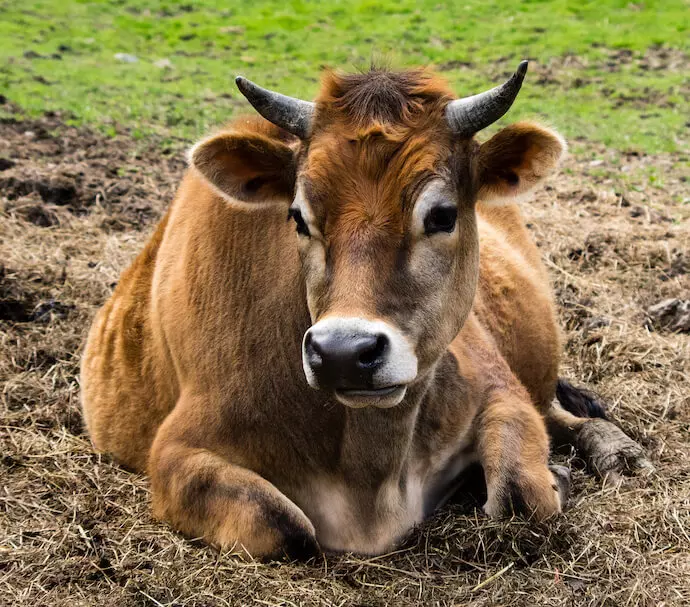At Catskill Animal Sanctuary, we want to support your vegan journey.
Whether you’re looking for vegan recipe books, local community groups, animal-friendly shops and restaurants, or online apps, here are some resources that can help:
iPhone and Android Apps
Find vegan and vegan-friendly restaurants near you, wherever you are.
An on-the-run guide to what’s vegan at popular chain restaurants and fast food places — now, with no internet connection required.
Instant access to hundreds of vegan, meatless and dairy-free recipes, with step-by-step instructions and high-definition photography, plus in-app subscription plans for unlimited access to more than 8,000 recipes, searchable via 600-plus category filters.
The number-one Food & Drink app, featured as ‘Best New App’ by Apple, from the makers of the critically acclaimed film Forks Over Knives, with more than 400 hearty and decadent, whole-food, plant-based meals from 20-plus leading chefs, with new recipes added weekly.
Blogs
Compassionate Cuisine: Add Love + Stir
Vegan recipes, product reviews, helpful tips and more, from Catskill Animal Sanctuary.
Vegan recipes, product reviews, helpful tips and more, from ChooseVeg, a project of Mercy For Animals, a 501(c)(3) nonprofit dedicated to promoting compassionate food choices and policies.
Cookbooks
The acclaimed vegan cookbook from Catskill Animal Sanctuary.
The dazzling debut cookbook from Joanne Lee Molinaro, the home cook and spellbinding storyteller behind the online sensation @thekoreanvegan
Plantiful: Over 75 Vibrant Vegan Comfort Foods.
Francesca Bonadonna, of Plantifully Based, delivers a fresh and creative approach to vegan cooking. She draws upon her Italian American heritage to bring familiar flavors and delectable dishes to your table.
Find your next favorite cookbook on Bookshop.org.
Community Groups and Events
Find and attend a Vegan Meetup near you, and join your local community.
Facebook Groups
Petunia’s Pals – The Facebook group run by CAS, where we welcome vegans, vegetarians, and the veg-curious.
Meet up with other vegans online, and share advice and solutions across the world.
A group for vegans or those seriously considering becoming vegan, throughout the world.
Documentaries
‘“You’ll never look at animals the same way again. Especially humans.”
‘Dominion’ is the feature-length documentary sequel to 2014’s Lucent. While Lucent focused mostly on the Australian pig farming industry, Dominion takes a much broader view as a comprehensive account of the numerous ways animals are used and abused in our food system.
Magazines
A print magazine, website, and e-newsletter with vegan recipes, news, reviews, trends, travel ideas, and more.
A print and online magazine featuring articles, recipes, news, blog and much more.
Starter Kits
Vegan meal plans, shopping guides, dining out tips, and everything else you need to become and stay vegan (other than our highly trained vegan mentors).
A downloadable/printable PDF guide with quick, easy and fun recipes for meatless meals.
Shopping
Luxurious vegan microfiber leather handbags
Luxurious vegan designer handbags made from recycled plastic bottles
Shop online for vegan foods, personal care and home products, vitamins and therapeutics, clothing, and more.
The UK’s No.1 Vegan Store for online vegan shopping
There’s More To Living Vegan Than Eating Animal-Free
From the moment we wake up to the moment we go to bed every day, we use a vast array of products to care for ourselves, our clothes, and our homes. When we choose what products to buy, we typically consider comfort, quality, aesthetics, performance, functionality, popularity, price, color, smell, etc. Most people don’t consider how an item is made, or what it’s made from; most also don’t realize that these everyday products typically harm animals and adversely impact our environment and our own health.
The good news is that — with the growing awareness of the harm everyday products cause — there are more and more animal-free options every day, and every dollar you choose to spend on a vegan product is a vote to help animals!
Learn more about what’s behind the products we use, and how you can make animal-free choices, starting today…
Leather, the skin of an animal, can be found in clothing, shoes, accessories, car seats, and many other items. Most leather comes from cows, including those that that are exploited for human food, but pigs, alligators, sea animals, dogs and cats are victims as well. No matter the source, animals suffer terribly for products that can be made without using them.
To produce leather, cows are often forced to walk miles to slaughterhouses; if they’re unable to walk, their tails are broken and chili seeds are rubbed in their eyes to force them to continue. Upon arrival, their throats are slit and they bleed to death, fully conscious, in front of other cows.
The making of leather also produces massive amounts of pollution that can destroy water sources, kill wildlife, and gravely affect human health.
Fortunately, animal-free choices exist. You can buy PU or PVC leather, or leather made of recycled plastics. There are also many innovative companies making leathers out of mushrooms, pineapples, tree fibers, and more.
Check the material by looking for words or symbols on the tags.
Foxes, minks, beavers and various other species are killed for their fur, which includes their hair and underlying skin. Their fur is found in coats, hats, clothing, trim, and decor.
Fur-bearing animals are held captive and experience immense suffering on fur farms, where they live a short life in cramped cages. They are typically poisoned, suffocated, or electrocuted to ensure that their fur is not damaged and can be sold.
More than half the fur in the United States is imported from China, where dogs and cats are common victims. Further, fur farms are essentially unregulated in most parts of the United States. Here, wild animals — who are used to living freely — panic and break down mentally in severe confinement. Also across the United States and worldwide, wild animals are captured, most commonly in steel-jaw traps, suffering for hours and even days; some gnaw their own limbs off to free themselves.
Thankfully, there’s no need to support this violence to stay warm or look cool. Furs and fur trim are required by law to be labeled as real or faux, so all you have to do is read clothing labels. Faux furs are easily found in stores and on fashion runways worldwide.
Wool is the hair of sheep, goats and other animals, which is used to make clothing, accessories, and housewares. Captive sheep are bred to produce excessive amounts of hair, at the expense of their physical and psychological health.
The majority of sheep are left to fend for themselves without food, shelter, or medical care. Millions die every year from pneumonia and starvation — and, in the end, all are killed for meat.
Across the world, sheep shearers are paid by the sheep, not by the hour, so they work quickly to cut off the wool. The sheep, who are barely handled outside of shearing time, are terrified and stressed during the procedure, and they are often injured in the process.
Merino sheep, a common breed used for wool, are bred to have wrinkled skin, which yields more wool and more profit. The wrinkles cause the sheep to sweat more and become infested with maggots. To prevent this, they are forced to endure an agonizing procedure called mulesing, where folds of skin around their behinds are cut away.
Fortunately, we can easily stay warm with other fabrics — without breeding, harming and killing sheep. For knitters and those who live in colder climates, there are many alternatives to wool, including a variety of animal-free yarn fibers. Plants like bamboo and soy can also be spun, and some inventive companies are even weaving products derived from kelp and recycled plastics.
Down comes from the light, fluffy inner layers of birds’ feathers, which the animals use to keep warm. Feathers of ducks and geese are used as insulators and fillers in clothing, pillows, bedding, and other items.
While some down comes from dead birds that have been killed for their flesh, other birds have their feathers ripped out when they are alive and fully conscious. (Imagine someone ripping out your hair by the fistful.) Their wounds may be crudely stitched up, or they’ll simply be left to bleed.
Thankfully, there are a number of types of synthetic down, including Primaloft®, Thermogreen® and CoconaTM. So, whether you’re looking for a coat, blanket or pillow, there are ample animal-free products available that will keep you equally comfortable and warm.
Many countries have banned the use of animals for cosmetic testing and, while animal testing is not legally required in the United States, some companies choose to do it anyway.
A wide variety of tests are used to study effects on the skin, eyes and organs, often without painkillers for the animals. The animals are then killed after the tests so their organs can be inspected.
Mice and rats, the most commonly used animals for testing, are bred for a variety of conditions to meet the demand from labs. Their short lives are full of pain and suffering. The same can be said for bunnies, primates, and other animals selected for testing.
Meanwhile, human cell cultures — grown from skin after surgeries — are actually more effective and scientifically sound than animal testing.
Fortunately, the Food and Drug Administration (FDA) does not require animal testing for cosmetics, and many animal-friendly alternatives exist. In fact, you can easily tell what products have not been tested on animals and do not contain animal products by checking for these labels:

As with cosmetics, using animals for testing is not required for household products. In fact, it is banned in many other countries.
However, many types of testing on animals continues unnecessarily. For example, the infamous LD50 test determines the amount of a chemical that will kill half of the animals exposed to it. A review of these tests found that studies of animals were 65% accurate in predicting toxicity, while the human cell-line tests were 75% to 80% accurate.
Thankfully, scientists are now able to grow 3D eye tissue from human cells and, using a technology called an “organ-on-a-chip,” they’ve even recreated the structure and function of real human organs.
Plus, buying products that are not tested on animals is as easy as checking for labels — the same labels seen above, as found on cosmetic products.





